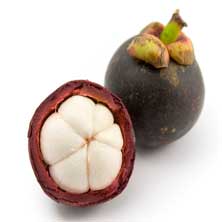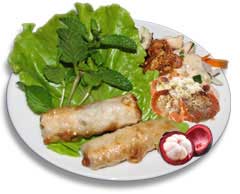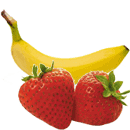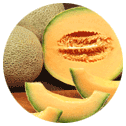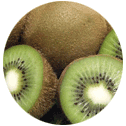 Full List of Fruits
Full List of Fruits  Mangosteen Fruit
Mangosteen Fruit
Mangosteen Fruit
The Mangosteen plant is a tropical evergreen tree, and it was originated in the Sunda Islands and the Moluccas. It was first exposed in Burma and Siam. The tree grows from 7 to 25 meters in height. This exotic edible Mangosteen fruit is deep reddish purple when it is ripe. In Asia, the Mangosteen fruit is identified as the "Queen of Fruits".
Fruit description - Mangosteen is a dark purple fruit with white on the inside of the fruit from Southeast-Asia, Thailand being one of its largest producers in the world. Even though mangosteen sounds like a mango type, it is really very different mango. Now it is always available at Asian markets across North America. Mangosteen is delectably sweet and juicy fruit that offers numerous health benefits of both the fruit itself and its skin which are incredibly potent disease fighters. Delicious as it is useful, the mangosteen fruit is always rich in xanthones, which may promote healthy physical function. In addition, mangosteen severing contains up to 5 grams of fiber. Its purplish pigment is also used as a dye.
Scientific Name:Garcinia mangostana
Taste - Mangosteen is very sweet. The mangosteen has flavors that taste like a combination of strawberry, peach, vanilla ice cream; it is definitely sweet with a very slight sourness. The flavor is divine with durian fruit and wonderfully delicate. The flavor does not even seem to resemble that of the fresh fruit. It has been described as tasting strawberry, peach, and vanilla ice cream. A mangosteen should be eaten as soon as it is opened.
Mangosteen tree and appearance of fruit - Mangosteen fruit grows on a tree with black color, but not just an ordinary tree. Mangosteen trees grow in deep rich soils only, and grow 20 to 80 feet in height. The tree has thick evergreen leaves, and blooms reaching upwards of a foot in width. The bark of the tree is nearly black in color. Fruits are harvested using a ladder or a cutting pole, but are in no way allowed to touch the ground normally. It would damage the fruit. The shell of the Mangosteen fruit looks tough and hard, but is easy to open with hands. Care must be taken when opening the fruit, as the reddish-black husk outside produces a purplish, inky juice that stains fabric and can be almost impossible to remove. To open a Mangosteen, the shell is usually broken apart, not cut. Holding the fruit in both hands, press it until the shell cracks.
- Grows 20 to 80 feet tall.
- Its bark is dark brown (nearly black) color.
- Have short, thick and leathery evergreen leaves and 12" wide flowers that grow in clusters of 3-9 at its branch tips.
- Takes two or more years for the tree to reach 12" in height.
- Widely believed that they originated in the islands of Sunda and Molucca (in the East Indies).
- The first fruit harvest may take place 7-9 years after planting, but most take place in the first 10-20.
- The average yield of full-grown trees is 500, but some trees yield as many as 5,000 ripe mangosteens.
- Some trees provide fruit for up to 100 years.
- The mangosteen tree is "ultra-tropical" and can't tolerate temperatures below 40°F or above 100°F. All attempts to grow the trees in locations north of 20° latitude have failed.
| Nutritive value per 100 g of Mangosteen | ||
| Principle | Nutritive value | |
| Dietary fibre | 1.8 g | |
| Sugar | - | |
| Protein | 0.4 g | |
| Fat | 0.6 g | |
| Carbohydrates | 18 g | |
| Calcium | 0.14mg | |
| Water | 81 g | |
| Iron | 0.003g | |
The rind decoction is taken to relieve diarrhea and cystitis, gonorrhea and gleet, and is applied externally as an astringent lotion. A portion of the rind is steeped in water overnight and the infusion given as a remedy for chronic diarrhea in adults and children. Filipinos employ a decoction of the leaves and bark as a febrifuge and to treat thrush, diarrhea, dysentery and urinary disorders.
1. Mangosteen Yogurt Panna Cotta
- 4oz mangosteen puree
- 8oz heavy cream
- 6 oz plain yogurt
- 1/2 cup sugar
- 1 tsp lime zest
- 1/2 tsp vanilla extract
- 3 gelatin sheets
- Soak the gelatin sheets in cold water for 2-3 minutes until softened, and then squeeze water.
- In a bowl, whisk together the yogurt, mangosteen puree, cream, lime zest, vanilla, and sugar until smooth.
- Strain the mixture through a fine sieve.
- In a small pan melt the gelatin over low heat, and stir in sugar and vanilla.
- Whisk the gelatin mixture thoroughly into the yogurt mixture.
- Pour the mixture into 4 glasses and frezze it until firm.
- 4 mangosteens
- 200g shrimps, boiled, shelled .
- 200g pork belly, boiled, cut into threads.
- 50g shredded dried squid
- lettuce,vietnamese herbs
- 2 lemon
- 2 tablespoons sugar
- 4 tablespoons mayonnaise sauce
- 1 tablespoon chilli sauce
- 1 tablespoon tomato sauce
- 1 tablespoon cooking oil
For the sauce:
- Combine all ingredients in a blender, and blend it until smooth.
- Pour mixture into shallow tray, place in freezer for 15-20 minutes or until set.
- Scoop mixture into mangosteen shells.
- Serve immediately.











